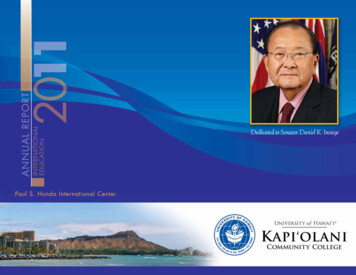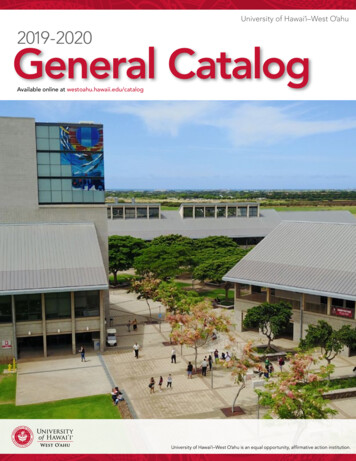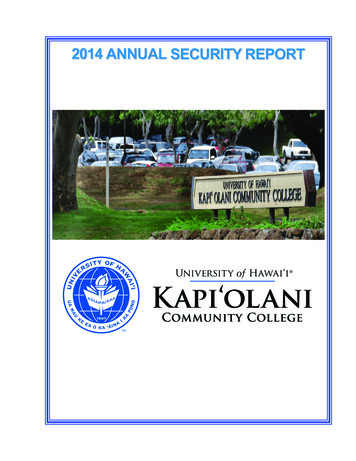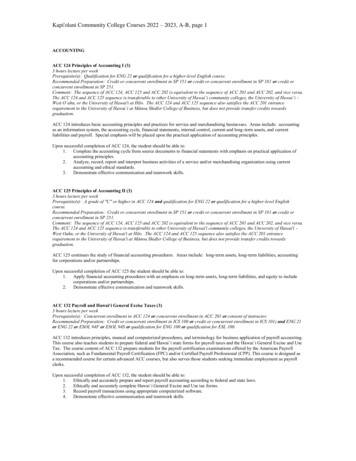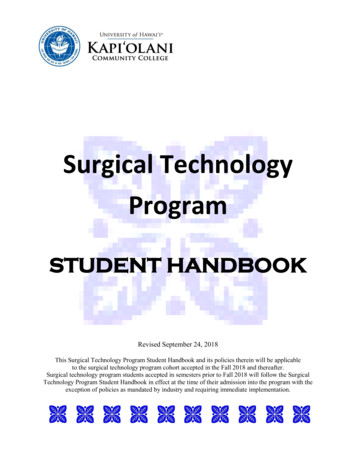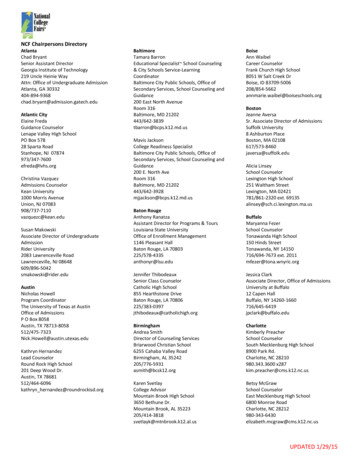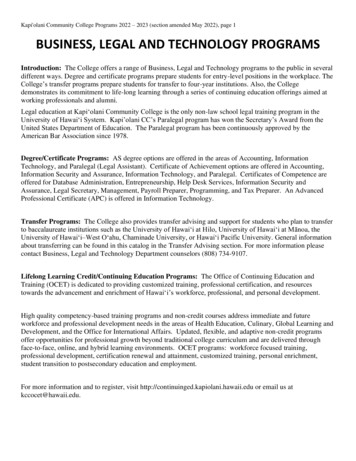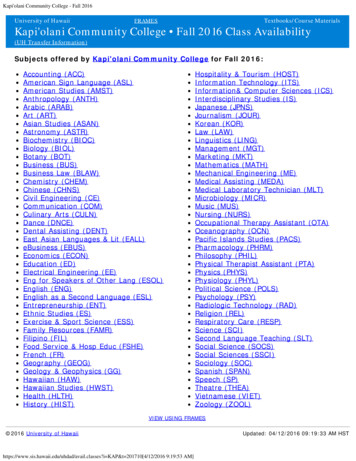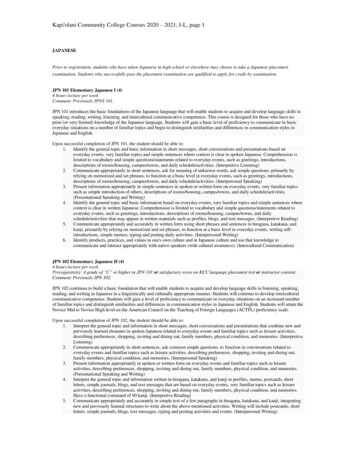
Transcription
Kapi'olani Community College Courses 2020 – 2021, J-L, page 1JAPANESEPrior to registration, students who have taken Japanese in high school or elsewhere may choose to take a Japanese placementexamination. Students who successfully pass the placement examination are qualified to apply for credit by examination.JPN 101 Elementary Japanese I (4)4 hours lecture per weekComment: Previously JPNS 101.JPN 101 introduces the basic foundations of the Japanese language that will enable students to acquire and develop language skills inspeaking, reading, writing, listening, and intercultural communicative competence. This course is designed for those who have noprior (or very limited) knowledge of the Japanese language. Students will gain a basic level of proficiency to communicate in basiceveryday situations on a number of familiar topics and begin to distinguish similarities and differences in communication styles inJapanese and English.Upon successful completion of JPN 101, the student should be able to:1. Identify the general topic and basic information in short messages, short conversations and presentations based oneveryday events, very familiar topics and simple sentences where context is clear in spoken Japanese. Comprehension islimited to vocabulary and simple questions/statements related to everyday events, such as greetings, introductions,descriptions of rooms/housing, campus/towns, and daily schedule/activities. (Interpretive Listening)2. Communicate appropriately in short sentences, ask for meaning of unknown words, ask simple questions, primarily byrelying on memorized and set phrases, to function at a basic level in everyday events, such as greetings, introductions,descriptions of rooms/housing, campus/towns, and daily schedule/activities. (Interpersonal Speaking)3. Present information appropriately in simple sentences in spoken or written form on everyday events, very familiar topicssuch as simple introduction of others, descriptions of rooms/housing, campus/towns, and daily schedule/activities.(Presentational Speaking and Writing)4. Identify the general topic and basic information based on everyday events, very familiar topics and simple sentences wherecontext is clear in written Japanese. Comprehension is limited to vocabulary and simple questions/statements related toeveryday events, such as greetings, introductions, descriptions of rooms/housing, campus/towns, and dailyschedule/activities that may appear in written materials such as profiles, blogs, and text messages. (Interpretive Reading)5. Communicate appropriately and accurately in written form using short phrases and sentences in hiragana, katakana, andkanji, primarily by relying on memorized and set phrases, to function at a basic level in everyday events, writing selfintroductions, simple memos, typing and posting daily activities. (Interpersonal Writing)6. Identify products, practices, and values in one's own culture and in Japanese culture and use that knowledge tocommunicate and interact appropriately with native speakers (with cultural awareness). (Intercultural Communication)JPN 102 Elementary Japanese II (4)4 hours lecture per weekPrerequisite(s): A grade of “C” or higher in JPN 101 or satisfactory score on KCC language placement test or instructor consent.Comment: Previously JPN 102.JPN 102 continues to build a basic foundation that will enable students to acquire and develop language skills in listening, speaking,reading, and writing in Japanese in a linguistically and culturally appropriate manner. Students will continue to develop interculturalcommunicative competence. Students will gain a level of proficiency to communicate in everyday situations on an increased numberof familiar topics and distinguish similarities and differences in communication styles in Japanese and English. Students will attain theNovice Mid to Novice High level on the American Council on the Teaching of Foreign Languages (ACTFL) proficiency scale.Upon successful completion of JPN 102, the student should be able to:1. Interpret the general topic and information in short messages, short conversations and presentations that combine new andpreviously learned elements in spoken Japanese related to everyday events and familiar topics such as leisure activities,describing preferences, shopping, inviting and dining out, family members, physical condition, and memories. (InterpretiveListening)2. Communicate appropriately in short sentences, ask common simple questions, to function in conversations related toeveryday events and familiar topics such as leisure activities, describing preferences, shopping, inviting and dining out,family members, physical condition, and memories. (Interpersonal Speaking)3. Present information appropriately in spoken or written form on everyday events and familiar topics such as leisureactivities, describing preferences, shopping, inviting and dining out, family members, physical condition, and memories.(Presentational Speaking and Writing)4. Interpret the general topic and information written in hiragana, katakana, and kanji in profiles, menus, postcards, shortletters, simple journals, blogs, and text messages that are based on everyday events, very familiar topics such as leisureactivities, describing preferences, shopping, inviting and dining out, family members, physical condition, and memories.Have a functional command of 90 kanji. (Interpretive Reading)5. Communicate appropriately and accurately in simple text of a few paragraphs in hiragana, katakana, and kanji, integratingnew and previously learned structures to write about the above-mentioned activities. Writing will include postcards, shortletters, simple journals, blogs, text messages, typing and posting activities and events. (Interpersonal Writing)
Kapi'olani Community College Courses 2020 – 2021, J-L, page 26.Identify and begin to compare products, practices, and values in one's own culture and in Japanese culture and use thatknowledge to communicate and interact appropriately with native speakers (with cultural awareness). (InterculturalCommunication)JPN 131 Japanese Conversation and Culture I/Business and Tourism Industry (4)4 hours lecture per weekComment: Previously JPNS 131.JPN 131 focuses on beginning level Japanese to develop oral communication skills. Includes oral drills and individual practice to formJapanese sentences. Also discusses cultural information and vocabulary relevant to successful interaction with a Japanese guest in thebusiness and visitor industry. Through an interactive, communicative approach, this course emphasizes immediate application ofcontent learned in situational role-plays and projects.Upon successful completion of JPN 131, the student should be able to:1. Recognize short utterances in Japanese.2. Orally produce simple, short sentences.3. Refer to present, past, and future events.4. Count money, people, and objects, and handle monetary transactions, using numbers 0 to 100,000,000.5. Recognize and use approximately 600 words, including those which express activities, location, time, duration, colors, size,and shapes.6. Perform limited business tasks such as retailing and taking orders on tables.7. Interact with clients in culturally acceptable ways, employing appropriate speech style, greetings, mannerisms, andimplications.8. Be familiar with a cultural perspective different from the student's own.JPN 201 Intermediate Japanese I (4) KCC AA/HSL4 hours lecture per weekPrerequisite(s): A grade of “C” or higher in JPN 102 or satisfactory score on language placement test or consent of instructor.Comment: If student has taken Japanese language prior to enrolling into College, taking the Japanese language placement test orseeing a Japanese language instructor is recommended.Comment: Previously JPNS 201.JPN 201 is a continuation of JPN 102 and the first half of an intermediate course on spoken and written Japanese. It is designed toreinforce the fundamentals of the Japanese language skills introduced in the elementary level. Students will further develop the fiveskills of listening, speaking, reading, writing and cultural competence.Upon successful completion of JPN 201, the student should be able to:1. Understand sentence-length utterances that consist of a recombination of new and previously learned elements in a limitednumber of content areas, such as health, travel, career planning and preparation, and asking for favors.2. Understand increased but limited number of simple paragraph-length utterances.3. Understand spontaneous face-to-face conversations as well as short routine telephone conversations and some deliberatespeech, such as simple announcements and reports.4. Handle a variety of uncomplicated, basic and communicative tasks and social situations. Ask and answer questions andparticipate in simple conversations in the aforementioned situations. Produce slightly longer utterances. Ask follow-upquestions to expand the conversation.5. Read consistently, with increased understanding, simply connected texts dealing with a variety of basic and social needs,such as personal letters, emails, messages, journals, Internet sources, and narrative accounts of events of interest. Suchtexts are written in hiragana, katakana, and about 214 frequently used kanji (87 kanji are introduced in this course).6. Obtain necessary information from simple authentic texts using skimming and scanning skills.7. Meet a number of simple practical writing needs, such as simple personal letters, emails, messages, and journals withcontent involving personal preferences, daily routine, everyday events, and other topics grounded in personal experience.Express and support opinions on topics grounded in personal experience.8. Speak and interact using culturally appropriate gestures, greetings, backchanneling, and body language.9. Text, chat, blog, or email appropriately in Japanese in a limited number of content areas using hiragana, katakana, andkanji.JPN 202 Intermediate Japanese II (4) KCC AA/HSL4 hours lecture per weekPrerequisite(s): A grade of “C” or higher in JPN 201 or satisfactory score on language placement test or consent of instructor.Comment: Previously JPNS 202.JPN 202 is the second half of an intermediate course on spoken and written Japanese. It continues to reinforce the fundamentals of theJapanese language skills introduced in the elementary level. It also aims at developing the functional ability to communicate inJapanese beyond the survival level. Students will attain the Intermediate Mid to Intermediate High level on the American Council on
Kapi'olani Community College Courses 2020 – 2021, J-L, page 3the Teaching of Foreign Languages (ACTFL) proficiency scale.Upon successful completion of JPN 202, the student should be able to:1. Sustain understanding over longer stretches of connected discourse on a number of topics, such as asking and givingdirections, gift exchanging, presenting cooking demonstration, expressing unpleasant experiences, rumors, and feelings,and honorific and humble expressions used in business environments.2. Handle successfully most uncomplicated communicative tasks and social situations attaining the Intermediate Low toIntermediate Mid level on the American Council on the Teaching of Foreign Languages (ACTFL) Proficiency GuidelineScale.3. Initiate, sustain, and close a general conversation with a number of strategies to a range of circumstances and topicsaforementioned.4. Produce limited number of connected discourse in descriptions and narration.5. Read consistently with full understanding simple connected texts dealing with basic personal and social needs about whichstudents have personal interest and/or knowledge.6. Obtain main ideas and information from descriptive and narrative texts using 301 basic kanji (87 new kanji will beintroduced in this course).7. Utilize online and Japanese dictionary apps to independently read Japanese text.8. Meet most practical writing needs and social demands.9. Write simple letters, emails, brief synopses and paraphrases, expression of opinions, summaries of biographical data, work,and school experience.10. Describe and narrate familiar topics in paragraphs.11. Text or chat spontaneously and blog or email appropriately in Japanese using hiragana, katakana, and kanji on the topicsaforementionedJPN 257 (Alpha) Japanese Culture and Language Through Content (4)4 hours lecture per weekPrerequisite(s): A grade of “C” or higher in JPN 102 or consent of instructor.Comment: JPN 257 (Alpha) is not intended to be used as a substitute for JPN 201 or JPN 202. Previously JPNS 257 (Alpha).JPN 257 (Alpha) is an intermediate-level language course using various content areas to further develop Japanese language skills andunderstanding of Japanese culture. Possible content areas include: History, Economics, Anthropology, Cuisine, Politics, PopularCulture, Film, Sociology, Music, and Geography/Demographics.Upon successful completion of JPN 257 (Alpha), the student should be able to:1. Identify Japanese patterns of social interaction and behavior.2. Describe various aspects of Japanese culture.3. Express the diversity and the linguistic variety in Japanese culture, orally and in writing.4. Explain how Japanese culture is influenced by globalization.5. Recognize the links between language and culture.6. Get information from written text as well as from other media.7. Use content as a tool for the investigation into language and culture.8. Express opinions orally and in writing about the content using appropriate vocabulary and grammar.9. Communicate content effectively through class discussions, written assignments, oral presentations, etc.10. Relate orally and in writing personal experiences related to the content.JPN 257B Japanese Culture and Language Through Content: Pop Culture – Anime (4)4 hours lecture per weekPrerequisite(s): A grade of “C” or higher in JPN 102 or consent of instructor.Comment: JPN 257B is not intended to be used as a substitute for JPN 201 or JPN 202. Previously JPN 257B.JPN 257B is an intermediate-level course focusing on learning the Japanese language through Pop Culture, specifically throughJapanese animations and videos. Japanese animations and videos provide the viewer with glimpses of the subtle and sometimes not sosubtle aspects of Japanese language and culture. Thus, if one views these with an eye for what can be learned about the Japaneselanguage, one's understanding of Japanese language and culture will increase significantly.Upon successful completion of JPN 257B, the student should be able to:1. Identify Japanese patterns of social interaction and behavior.2. Describe various aspects of Japanese culture.3. Express the diversity and the linguistic variety in Japanese culture, orally and in writing.4. Explain how Japanese culture is influenced by globalization.5. Recognize the links between language and culture.
Kapi'olani Community College Courses 2020 – 2021, J-L, page 46.7.8.9.10.11.12.13.14.15.16.17.Get information from written text as well as from other media.Use content as a tool for the investigation into language and culture.Express opinions orally and in writing about the content using appropriate vocabulary and grammar.Communicate content effectively through class discussions, written assignments, oral presentations, etc.Relate orally and in writing personal experiences related to the content.Produce and respond to sentence-length utterances that consist of a recombination of new and previously learned elementsin a limited number of content areas found within pop culture as seen through anime.Engage in spontaneous face-to-face conversations dealing with a variety of basic and social needs that use the grammaticalpatterns and vocabulary found within anime.Handle a variety of uncomplicated, basic and communicative tasks and social situations found within anime.Look up unknown vocabulary and phrases found in anime by using dictionaries to create personal vocabulary and patternlists.Identify ways in which the language is influenced by the culture as demonstrated through the behavior of the characters inanimation and video.Identify Japanese patterns of social interaction as seen in anime.Use Japanese social phrases and manners learned from anime.JPN 257C Japanese Culture and Language Through Content: Japanese History - Understanding the Samurai Culture (4)4 hours lecture per weekPrerequisite(s): A grade of “C” or higher in JPN 102 or consent of instructor.Comment: JPN 257C is not intended to be used as a substitute for JPN 201 or JPN 202. Previously JPNS 257C.JPN 257C is an intermediate-level Japanese course that utilizes the Japanese language to learn about the Samurai Culture in Japanesehistory. The course will focus on the language to learn how the culture of the samurai developed from the Kamakura Period in the late1100s out of the clanships. This course will also include the influence of Zen Buddhism on the culture of the samurai and the changeof the samurai from warrior to courtier during the Tokugawa period (1603 to 1867). This course will also discuss the changes in theJapanese language and the impact of the samurai culture on modern Japan.Upon successful completion of JPN 257C, the student should be able to:1. Identify Japanese patterns of social interaction and behavior.2. Describe various aspects of Japanese culture.3. Express the diversity and the linguistic variety in Japanese culture, orally and in writing.4. Explain how Japanese culture is influenced by globalization.5. Recognize the links between language and culture.6. Get information from written text as well as from other media.7. Use content as a tool for the investigation into language and culture.8. Express opinions orally and in writing about the content using appropriate vocabulary and grammar.9. Communicate content effectively through class discussions, written assignments, oral presentations, etc.10. Relate orally and in writing personal experiences related to the content.11. Produce and respond to sentence-length utterances that consist of a recombination of new and previously learned elementsin a limited number of content areas as seen through the study of samurai culture.12. Engage in spontaneous face-to-face conversations dealing with a variety of basic and social needs that use the grammaticalpatterns and vocabulary found within the study of samurai culture.13. Handle a variety of uncomplicated, basic and communicative tasks and social situations found within the study of samuraiculture.14. Look up unknown vocabulary and phrases found in the study of samurai culture by using dictionaries to create personalvocabulary and pattern lists.15. Identify Japanese patterns of social interaction as seen in the study of samurai culture.16. Use Japanese social phrases and manners learned from the study of samurai culture.JPN 290 Japanese Language and Culture through Cross-Cultural Communication (4)4 hours lecture per weekPrerequisite(s): ENG 100 with a grade of "C" or higher or ESL 100 with a grade of "C" or higher; and Instructor approval andcompletion of a minimum of 12 credits at Kapiʻolani CC; and students must be a graduate of a Japan Ministry of Educationaccredited high school or have an advanced high rating on the ACTFL proficiency scale.Comment: Letter grade only. JPN 290 may not be audited. JPN 290 may not be taken credit/no credit. Previously JPNS 290.JPN 290 embraces the students' experiences studying and living abroad in Hawaii. The course will further develop and refineinterpersonal, presentational, interpretive, and cross-cultural communicative skills of native or near-native Japanese languagespeakers. Students will research and analyze Japanese language and culture from a socio-linguistic, historical and geographicalperspective, develop cultural awareness, effectively convey knowledge about Japanese culture and communicate through crosscultural communication. Students will develop critical thinking and problem-solving skills while examining case studies andparticipating in discussion and debates on social issues in Japan. Students will learn to unpack their study abroad experience in theU.S./Hawaii, reflect on their experience, the marketable skills they have and the skills they need to develop, and how they can connectthose skills to the needs of the global workforce.
Kapi'olani Community College Courses 2020 – 2021, J-L, page 5Upon successful completion of JPN 290, the student should be able to:1. Demonstrate proficiency of the Japanese language and culture at the superior level on the American Council for theTeaching of Foreign Languages (ACTFL) scale in interpersonal, interpretive, and presentational modes.2. Discuss topics covered in the course in detail, and provide lengthy and coherent narrations, all with ease, fluency, andaccuracy.3. Present opinions on a number of issues of interest, such as social and political issues, and provide structured arguments tosupport these opinions while demonstrating problem solving skills and critical thinking skills.4. Produce most kinds of formal correspondence, in-depth summaries, reports, and research papers on selected social andacademic topics.5. Demonstrate the ability to explain complex matters, present and support opinions by developing cogent arguments andhypotheses using effective organization, lexicon, and writing protocols and demonstrating problem solving skills andcritical thinking skills.6. Describe similarities and differences between Japanese and U.S. culture from various perspectives and values.7. Unpack study abroad experience in the U.S./Hawaii, identify marketable skills they have and how they can connect thoseskills to the needs of the global workforce.JOURNALISMJOUR 150 Journalism and Society (3) KCC AA/DS3 hours lecture per weekPrerequisite(s): Qualification for ENG 100 or ESL 100.JOUR 150 surveys the forces that shape the way society communicates, the impact of mass media on the political, social and culturalclimate of America and the world; and the roles of technology, business, government and the courts, and personalities in shapingmedia industries.Upon successful completion of JOUR 150, the student should be able to:1. Describe the major communication processes and the developments that changed the way in which information isexchanged.2. Explain how changes in the way people communicate have affected the ways in which societies/communities organize anddefine themselves.3. Identify the major factors involved in the development of the print, radio/music, television and film industries, includingtechnological development, landmark government legislation and court decisions, and key personalities.4. Explain the impact each of the major media industries has made on American society.5. Identify visual and other techniques used to persuade or sell in TV news, films, videos and magazines.6. Describe the ways the advertising industry uses technology and research to target audiences for consumer goods andpolitical candidates.7. Explain how public relations operates and its role in our society today.8. Explain how the American legal system attempts to balance First Amendment rights with the rights of the privateindividual in the areas of libel, privacy, fair trial and copyright.9. Describe the ethical codes, laws, and regulations that govern the major media industries and identify the governmentagencies that oversee the media.10. Apply the Society of Professional Journalists Code of Ethics to the handling of news on campus and in the community.11. Describe media convergence in the 21st century and its impact on society.JOUR 205 Newswriting (3)3 hours lecture per weekPrerequisite(s): A grade of "B" or higher in ENG 100 or a grade of "B" or higher in ENG 160 or a grade of "B" or higher in ESL 100or consent of instructor.JOUR 205 focuses on the basic principles of writing for media: understanding audience and purpose, developing a focus, gatheringinformation efficiently, writing basic news story formats with speed and accuracy, using the Associated Press style sheet, and applyingethical and legal standards.Upon successful completion of JOUR 205, the student should be able to:1. Identify the basic characteristics of news.2. Identify audience and purpose for any given news story.3. Identify hard and soft news story formats and their purposes.4. Develop story ideas from a variety of sources, including interview, observation, appropriate spin-offs from world andnational headline news, statistical data, and the Internet.5. Interview a subject using appropriate questions and strategies, including email.6. Use several note-taking strategies, including tape recorder.7. Gather information by networking and through observation, Internet, library sources, city and telephone directories and
Kapi'olani Community College Courses 2020 – 2021, J-L, page 6electronic databases.8. Write hard and soft news leads, including breaking news, second day, delayed ID, quote, contrast, impact and soft leads.9. Develop a story using summary, paraphrase, quotation, description, narration, and analogy.10. Write news stories using the following formats: inverted pyramid, hourglass, list, Wall St. Journal, narrative, speech/meeting advance and follow-up, obituaries, press releases, and short personality profiles.11. Use the Associated Press Style.12. Understand and apply legal guidelines such as libel, fair comment and criticism, qualified privilege, privacy, copyright,obscenity.13. Apply the Society of Professional Journalists' Code of Ethics to all news coverage.14. Demonstrate an awareness of the rights, interests, and sensitivities of minorities. Write articles acceptable for publication inthe school newspaper, both print and Web versions.JOUR 227 Writing for Publication (3)3 hours lecture per weekPrerequisite(s): A grade of “C” or higher in ENG 100 or consent of instructor.JOUR 227 focuses on writing news, feature and opinion articles for publication in newspapers, magazines, and other print and onlinemedia. Emphasis is placed on developing sound information gathering methodologies and identifying and executing appropriate focus,tone and structure for articles based on purpose, audience, context and medium. Work may be published in campus print and onlinepublications.Upon successful completion of JOUR 227, the student should be able to:1. Explain the functions and conventions of public affairs reporting.2. Write clearly, correctly, and concisely in contemporary journalistic style.3. Produce well-structured articles that clearly identify news value in lead and transitory paragraphs.4. Adapt writing for various platforms, including print and online media.5. Select appropriate research methodologies, including primary and secondary research, to gather information from the mostrelevant and credible sources.6. Demonstrate basic mastery of Associated Press style.7. Edit for punctuation, grammar, word choice and appropriate style and format.8. Adapt writing for public relations purposes, including composition of a press release.9. Provide appropriate and ethical attribution of source material.10. Demonstrate understanding of First Amendment rights and legal and ethical constraints in areas of copyright, privacy, libeland obscenity.11. Apply Society of Professional Journalists Code of Ethics to reporting and writing.12. Identify various markets for publication and standard procedures.13. Gather, analyze and organize information, and to communicate it clearly, effectively and responsibly using multiple mediaplatforms.14. Demonstrate an understanding of the social, cultural and historical contexts of reporting on social institutions as well as onindividuals and groups.15. Demonstrate an understanding of the importance of a free, vigorous and responsible press to the maintenance of aninformed citizenry to exercise the rights of self-governance in a democracy.16. Contribute to lifelong learning through reports that enlighten and enliven audiences, whether in print, broadcast, online orother new media formats.JOUR 250 Media Writing (3)3 hours lecture per weekPrerequisite(s): A grade of “C” or higher in ENG 100 or consent of instructor.JOUR 250 focuses on writing news, feature and opinion articles for publication in newspapers, magazines, and other print and onlinemedia. Emphasis is placed on developing sound information-gathering methodologies and identifying and executing appropriatefocus, tone and structure for articles based on purpose, audience, context and medium. Work may be published on campus print andonline publications.Upon successful completion of JOUR 250, the student should be able to:1. Explain the functions and conventions of public-affairs reporting.2. Write clearly, correctly, and concisely in contemporary journalistic style.3. Produce well-structured articles that clearly identify news value in lead and transitory paragraphs.4. Adapt writing for various platforms, including print and online media.5. Select appropriate research methodologies, including primary and secondary research, to gather information from the mostrelevant and credible sources.6. Demonstrate basic mastery of Associated Press style.7. Edit for punctuation, grammar, word choice and appropriate style and format.8. Adapt writing for public relations purposes, including composition of a press release.
Kapi'olani Community College Courses 2020 – 2021, J-L, page 79. Provide appropriate and ethical attribution of source material.10. Demonstrate understanding of First Amendment rights and legal and ethical constraints in areas of copyright, privacy, libeland obscenity.11. Apply Society of Professional Journalists Code of Ethics to reporting and writing.12. Identify various markets for publication and standard procedures.KOREANKOR 101 Elementary Korean I (4)4 hours lecture per weekKOR 101 introduces the basic foundations of the Korean language that will enable students to acquire and devel
JPN 202 Intermediate Japanese II (4) KCC AA/HSL 4 hours lecture per week Prerequisite(s): A grade of "C" or higher in JPN 201 or satisfactory score on language placement test or consent of instructor. Comment: Previously JPNS 202. JPN 202 is the second half of an intermediate course on spoken and written Japanese.
